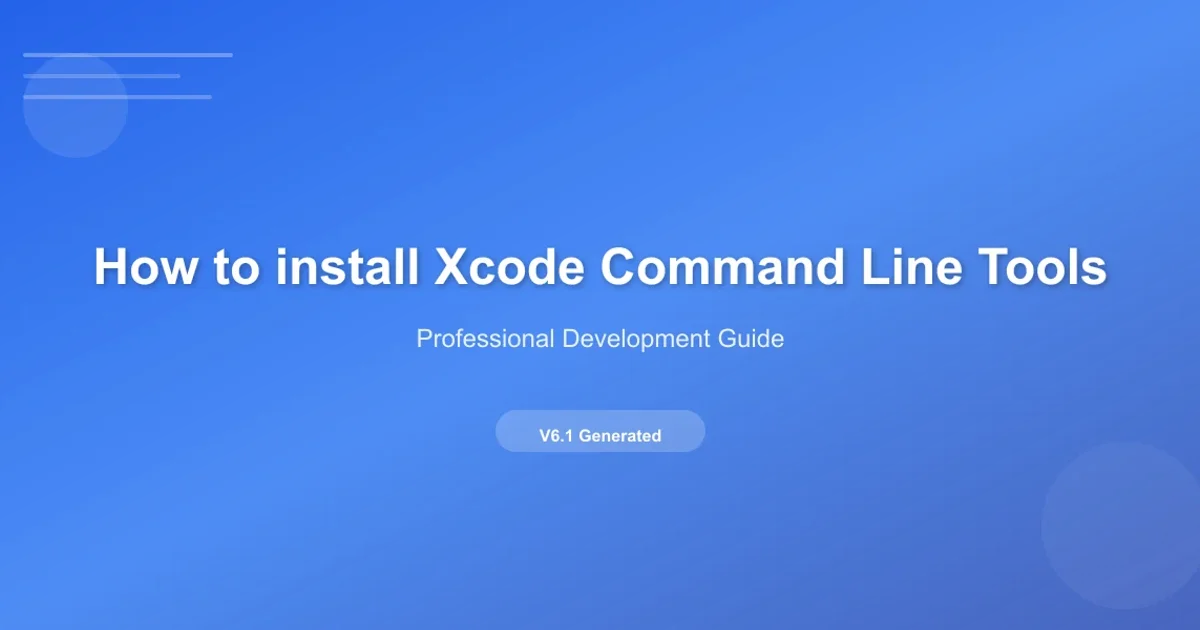How to install Xcode Command Line Tools
Categories:
How to Install Xcode Command Line Tools on macOS

A comprehensive guide to installing and managing Xcode Command Line Tools, essential for developers and system administrators on macOS.
The Xcode Command Line Tools are a collection of essential development utilities for macOS that run in the terminal. These tools include compilers (like clang), debuggers (lldb), and other utilities (like git, make, perl, python, ruby, svn) that are crucial for building software, managing version control, and performing various system-level tasks. While Xcode itself is a large IDE, many developers only need these command-line tools for their workflows. This article will guide you through the installation process and common usage scenarios.
Understanding the Xcode Command Line Tools
The Xcode Command Line Tools package is a separate, lightweight download from the full Xcode IDE. It provides the core Unix tools and compilers necessary for development without requiring the entire Xcode application. This is particularly useful for server environments, automated build systems, or developers who prefer using other IDEs or text editors with command-line compilation. Installing these tools is often a prerequisite for many open-source projects, package managers like Homebrew, and various development frameworks.
flowchart TD
A[Start] --> B{Do you have Xcode installed?}
B -->|Yes| C[Tools might be bundled]
B -->|No| D[Install Command Line Tools directly]
C --> E{Check if tools are active}
D --> F[Run 'xcode-select --install']
E -->|Active| G[Tools are ready]
E -->|Not Active| F
F --> H[Follow on-screen prompts]
H --> GDecision flow for installing Xcode Command Line Tools.
Installation Methods
There are two primary ways to install the Xcode Command Line Tools: directly via the terminal or by installing the full Xcode application. The terminal method is generally preferred for its simplicity and smaller footprint if you don't need the full IDE.
1. Method 1: Install via Terminal (Recommended)
Open your Terminal application (found in Applications/Utilities) and execute the following command. This command will prompt a software update dialog, guiding you through the installation.
2. Follow the Prompt
A dialog box will appear asking if you'd like to install the command-line developer tools. Click 'Install' and agree to the terms and conditions. The download and installation process will begin.
3. Verify Installation
Once the installation is complete, you can verify that the tools are correctly installed by attempting to use a command like git or clang.
xcode-select --install
Command to initiate the Command Line Tools installation.
git --version
clang --version
Verify installation by checking tool versions.
xcode-select: error: command line tools are already installed, it means you already have them. You might need to update them or ensure the correct path is set.1. Method 2: Install by Installing Xcode
If you require the full Xcode IDE, you can download it from the Mac App Store. Installing Xcode automatically includes the Command Line Tools. After installation, you might need to explicitly select the Xcode path.
2. Download Xcode
Search for 'Xcode' in the Mac App Store and click 'Get' or 'Install'. Be aware that Xcode is a very large application (tens of gigabytes) and will take a significant amount of time to download and install.
3. Open Xcode and Accept License
After installation, open Xcode at least once. You will be prompted to accept the license agreement and install additional components. This step is crucial for the Command Line Tools to be fully configured.
4. Select Xcode Path (if necessary)
Even after installing Xcode, sometimes the system doesn't automatically link the command-line tools. You can manually set the path using xcode-select.
sudo xcode-select --switch /Applications/Xcode.app/Contents/Developer
Command to set the Xcode developer directory path.
sudo command requires administrator privileges. You will be prompted to enter your macOS user password.Updating and Managing Tools
Keeping your Command Line Tools updated is important for compatibility and security. macOS usually prompts you for updates, but you can also manage them manually.
softwareupdate --list
softwareupdate --install -a
Check for and install all available macOS software updates, including Command Line Tools.